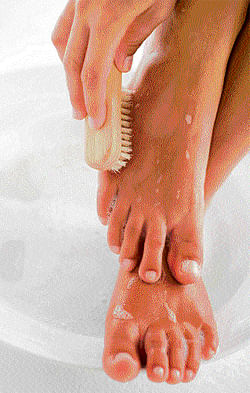
Every month, Living carries a column on beauty tips by our grooming expert, Shahnaz Husain. Send in your queries to dhliving @gmail.com.
The main problem in humid weather conditions is perspiration. The waste matter, which is secreted with sweat, has to be removed by daily washing to eliminate odour and to feel fresh and clean. The feet are areas where germs accumulate and odour lingers.
Pay special attention to your feet while bathing. After washing them well, dry them thoroughly and apply talcum powder. If you wear closed shoes, talcum powder can be sprinkled inside the shoes. However, during summer, slippers and open sandals are the best, as they allow maximum ventilation and help the perspiration to evaporate.
But open footwear attracts dirt and therefore, foot hygiene becomes all the more important. After a hot day outdoors, soak your feet in cold water, to which some salt has been added.
Athlete’s foot
Athlete’s foot develops more easily during hot and humid weather because the condition sets in on skin that is damp. It starts as a fungal infection, and so if there is dry scaling on the feet, especially between the toes, with some itching, be sure to consult a dermatologist without delay.
Anti-fungal preparations are effective in dealing with the problem during the initial stages. Excessive moisture caused by excessive sweating, tight shoes and humid weather can lead to bacterial activity and this worsens the condition. Avoid socks and wear open shoes, use talcum powder and keep the feet as dry as possible. In fact, your feet should be exposed to the air outside as much as possible.
Weekly pedicures help to keep the feet and nails clean and prevent fungal infections. Here’s how you can treat yourself to one:
After removing old nail polish, soak your feet in one-fourth a bucket of warm water, add half a cup of coarse salt and 10 drops of lemon or orange essential oil (if you cannot get essential oil, use half a cup of lemon or orange juice). If your feet tend to sweat a lot, use a few drops of tea tree oil to prevent germs from collecting and harvesting eggs.
Tea tree oil, besides its germicidal properties, can greatly disguise a strong odour too. Soak your feet for 10 to 15 minutes and then clean your nails with a soft-bristled brush. Use a pumice stone on the heels and side of the soles. You can also scrub your entire foot with a rough towel or loofah. Scrubbing removes germs.
When this is done, wash your feet with clean water. Dry thoroughly with a towel.
If your nails need cutting, use a nail clipper. Cut toe nails squarely across. Use an emery board to smoothen them. Round off toenails to prevent in-growth of nails. Do not cut the cuticles of the toenails. Apply a moisturiser and push them back gently with a cotton bud.
Apply cream on your feet and nails, and massage it into the skin, working it into the cuticles. Do not use sharp instruments to clean. Pay special attention to the heels, applying more cream if needed. Use upward strokes while massaging from the toes towards the ankles. Wipe with a moist towel and then apply talcum powder.
If you wish to apply polish, put some cotton wool between the toes. Apply nail varnish in broad strokes, from the base of the nail to the nail tips. After the first coat dries, apply the second coat of colour.
Foot lotion: Mix together three tablespoons of rose water, two tablespoons of lemon juice and a teaspoon of pure glycerin. Apply this on your feet and leave it on for half an hour.
Cooling foot bath: Add rose water, lemon juice and a splash of any Eau de Cologne in cold water and soak your feet in it. This cools, cleans and removes odour.
Cooling massage oil: Take 100 ml of olive oil and add two drops of eucalyptus oil, two drops rosemary oil and three drops of khus or rose oil. Mix together and store this in an airtight glass jar. Use a little of this for foot massage. It cools and protects the skin.